Last of two parts
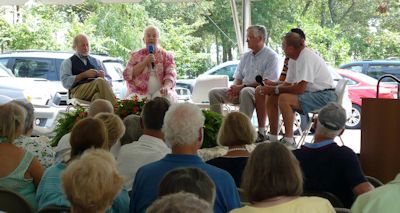 Janice Ray Lewis Ditto, second from left, talks about growing up in the Promise Land at a reunion of descendants of Shackleford Banks fishing families. Photo: Core Sound Waterfowl Museum & Heritage Center |
HARKERS ISLAND – Ca’e Bankers were no strangers to foul weather. They lived at the water’s edge, in scattered, isolated settlements on what is now uninhabited Shackleford Banks in Cape Lookout National Seashore. Blows of various intensities were part of life: Frigid, winter nor’easters howled for days, summer squalls with dangerous lighting and winds that could capsize a fishing boat appeared suddenly on the horizon. Most feared, though, were the hurricanes, as yet unnamed, that blew up from the tropics in late summer and fall.
Supporter Spotlight
It was back in the days before all-seeing satellites and clever computer models. The Bankers knew only what the sky and sea told them.
And the signs were not good on Aug. 16, 1899. The ocean’s swells were larger than usual and the high tides that day inched farther up the beach. A brisk breeze blew out of the northeast, and cirrus clouds streaked the sky.
If they had had access to a newspaper, the Bankers would have read horrifying accounts of a hurricane that struck Puerto Rico a week earlier, killing hundreds. The storm hit on the day Puerto Ricans honored Saint Ciriaco, who had been stoned by the Romans for refusing to renounce his faith. God then sent torrential rains to prevent the Romans from burning the body, allowing Ciriaco’s family and friends to give him his well-deserved Christian burial. That such a storm hit on such a day proves nothing except maybe that God does indeed have mysterious ways and a wicked sense of humor.
What later became known to history as the San Ciriaco Hurricane was one of the most powerful cyclones to move through the western Atlantic in the 19th century. It struck the barrier islands of North Carolina on Aug. 17 with wind gusts that approached 160 miles an hour. The devastation from Beaufort to Nags Head was nearly complete. On the low-lying Banks, there was nothing near about it.
The waters came first from the ocean, then from the sound. Every house on the island was flooded, many were destroyed. Boats were splintered. Goats, sheep and cows were drowned or simply disappeared. Wells were undrinkable and the soil so contaminated with saltwater that nothing would grow in it.
Supporter Spotlight
The worst thing, though, were the caskets. They floated up out of the ground.
The Promise Land
 Charlie Brown Lewis tends his net spreads at the end of 12th Street in the Promise Land. Photo: Core Sound Waterfowl Museum & Heritage Center |
The migration off the island had started as a trickle as early as the 1870s. Some Bankers wanted a different life, others a better education for their children. Hurricanes earlier in the 1890s quickened the exodus. But after that day in August 115 years ago, the island was no longer inhabitable. By 1902, the Banks were deserted.
Many of the refugees loaded their possessions, including their houses, onto small boats and sailed the two miles across Back Bay to Harkers Island. Others ended up in Marshallberg or Salter Path on Bogue Banks. Still others started anew in what was then an undeveloped section of Morehead City.
The neighborhood the Bankers created there along Bogue Sound became known as the Promise Land. Stretching from the railroad track along Arendell Street south to the sound, between 10th and 15th streets, it is now a very desirable place with expensive houses lining the water. The descendants of the original settlers have formed their own society to celebrate their history and heritage. They have a festival each October and have even published two books full of reminisces and photographs.
It wasn’t always that way, noted Rodney Kemp, a local historian who lives on Shepard Street in the Promise Land. Though not a descendant of a Ca’ Banker, Kemp has been adopted by those who are. “Some people didn’t want to be Promise Landers, as terrible as that sounds,” he said. “They didn’t like the stigma that they were ignorant fishermen.”
Janice Ray Lewis Ditto, whose people came from the Banks and who grew up in the Promise Land, felt the bigotry first hand. “They thought we were ignorant,” she told a crowd of Ca’e Banks’ descendants who gathered last month at the Core Sound Waterfowl Museum & Heritage Center on Harkers Island for a two-day reunion. “We were speaking a different language. We were the poor people who moved to town. We were shunned at school. The Promise Land is now a wonderful place, but we worked night and day to do that.”
The bigotry is reflected in the stories of how the neighborhood got its name. One version has a prominent Morehead City resident reminded of the Old Testament when he witnessed another sailskiff loaded with refugees coming down Bogue Sound. He said admiringly that it was like the Israelites heading for the Promised Land. Another version is similar, but the speaker spits out the words derisively, “So you think you’ve found the Promised Land?”
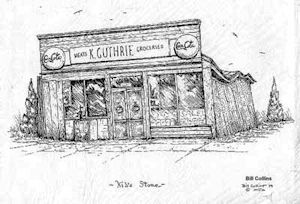 Kib Guthrie’s store, with its distinctive lean, was the unofficial town hall of the Promise Land. Illustration: Core Sound Waterfowl Musuem & Heritage Center |
Whichever version you ascribe to, just make sure you drop the “d.” And don’t add an apostrophe, as is sometimes done. As one descendant told Kemp, “We don’t talk in apostrophes.” It’s simply “Promise Land.”
The original lots along the water sold for as little as $10, Kemp explained. The goal was to accumulate enough money to move to higher ground near the railroad track, he said. “The idea was to get away from the flooding,” Kemp noted.
The beach between 10th and 15th streets was known as The Landing and was the center of activity in the neighborhood. Fishermen tied up their boats there and spread out their nets to dry in the sun. Neighborhood kids used it as their playground.
If The Landing was the Promise Land’s community center then Kib Guthrie’s Store on the corner of 12th and Evans streets was its town hall and its owner, Kilby Guthrie Jr., its unofficial mayor. “Step right up, don’t be ashame,” Guthrie would say to customers when they walked in. “Go to Charlie Wallace’s for your purse seine.”
Adolya Guthrie Bennett, 83, remembers Kib and his store with the distinctive “east’ard” lean. She remembers running through the net spreads as a child and the old net house on Shepard Street where she grew up.
“The floor was dirt and the walls were cardboard boxes from the store,” Bennett said. “But I went to bed every night and knew that I was loved. We never had nothing, but we would never go hungry. The men from the Promise Land would come by and say ‘I got some nice oysters’ or ‘I got some sea mullet.’ I’ve got scales for skin because I’ve eaten so many fish.”
The Mayflower Whale
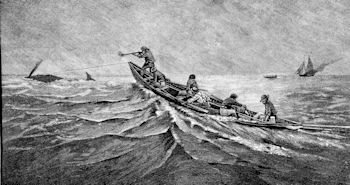 Nineteenth century whalers hunt a whale with harpoons and a whale gun. Illustration: National Archives |
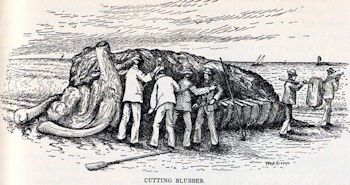 Whalers on Shackleford Banks cut the blubber from a whale. Illustration: N.C. Division of Archives and History |
Capt. Reuben Willis was the first of the six boats to reach the pod of 10 right whales that had come into the Lookout Bight early in the morning of May 4, 1874. Willis stood in the high bow of the 25-foot-long boat, directing his crew of four oarsmen and the man in the stern with the steering oar towards one of the whales, which looked to be about 50-feet long. They had to evade the trashing tail yet get close enough for Willis to accurately throw the harpoon.
Closer, Willis urged his crew. Just a little closer, lads.
He threw the harpoon, aiming for the vital organs just below the blow hole. The weapon flew straight with its line tailing behind it. Called a toggle iron, the harpoon was one of two types of hand-thrown weapons used by 19th century whalers. Its spear point was affixed to the shaft by a pin. By pulling on the line, the whaler would pivot, or toggle, the point to a right angle after the harpoon struck the whale. Once set, the harpoon wouldn’t come out and the whaler was then “fixed” to his prey. The other type of harpoons had razor sharp edges designed to penetrated deep into the whale.
Willis’ harpoon hit its mark, and the captain pulled mightily on the line to fix the point. The whale’s tail came up below the boat, flipping it over and throwing Willis and his crew into the water.
A gasp went up from shore. Families from Cape Hills and Diamond City, from Bell’s Island and Bald Hill Bay, from Sam Windsor’s Lump and Whale Creek gathered on the beach to anxiously watch the battle. Mothers said silent prayers for their boys manning the oars.
Capt. Josephus Willis and his Red Oar Crew approached next. Capt. Seef brought the heavy whale gun to his shoulder. Such guns were common by the 1870s. Made by various manufacturers, they fired small harpoons and lances that exploded inside the whale. The benefits were obvious. The whaler could fire his harpoons from a safer distance and they would penetrate deeper into tough blubber.
James Templeman Brown, in his 1887 book The Whale Fishery, described the major failing of all these guns: “…the gunner was kicked as far aft as ‘midships, and it was found necessary then, even as it is now, to tie the gun to the boat with a lanyard in order that it could be regained when it was ‘hoisted overboard.’ The recoil of the old shoulder-guns was immense. I have heard of two men who had their collar bones broken by a heavy gun.”
Willis’ gun packed a meaner kick than most. Gun makers Julius Grudchos and Selmar Eggers of New Bedford, Mass., wanted to make a lighter whale gun when they designed this model in 1857. They succeeded in making a gun that was several pounds lighter than the competition. That meant, though, that its recoil was greater.
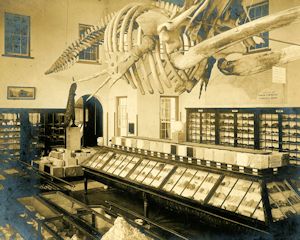 The skeleton of the Mayflower Whale hangs in the N.C. Museum of Natural Science around 1900. Photo: N.C. Museum of Natural Sciences |
Capt. Seef was an old hand at this, though, and fired his gun apparently without incident.
It took most of the day to kill the whale, and Capt. Seef was credited with striking the mortal blow. When the bloody business was over, the boats encircled the animal and the crews held their oars straight up in the air and gave three loud whoops. That was the sign for the people watching along the shore to “put on the pots.”
Capt. Absalom Guthrie, an island elder, was in charge of coordinating processing the whale. Almost everyone had a job. Crews cut the blubber into chunks that the women and children toted ashore in wash tubs and dumped into large iron kettles or “trypots.” Some women were charged with fixing meals or getting fresh water; others gathered up the driftwood to keep the fires going. Then there were the dippers who used ladles to dip out the oil in the kettles when it was separated from the blubber.
The tradition on the Banks was to name each whale taken. There was the Lee Whale and the Tom Martin Whale, the John Rose Whale and the Little Children’s Whale. That one was named after the young boys who took the oars in the whaleboats because most of the men were away when the whale was sighted. They called this one the Mayflower Whale after the month it was killed and the flower-like markings on its side.
The whale ended up producing more than 40 barrels of oil and 700 pounds of baleen that were worth several thousand dollars in Beaufort. Its unexpected value as a teaching tool, though, has been priceless, as they would say in the TV commercial.
It’s not clear how John D. Whitford, the president of the old Atlantic and North Carolina Railroad, came to own the skeleton of the Mayflower Whale, but he donated it to the N.C. Museum of Natural Sciences in 1876. No one on the museum’s small staff knew how to assemble a bunch of whale bones. So the skeleton lay under a table for the next 18 years until the state hired a naturalist and taxidermist H.H. Brimley in 1893. Though he had no experience with whales, Brimley set about cleaning decades of dust and tobacco juice from the whale bones and putting them together with steel rods and wire.
The assembled skeleton was first exhibited in April 1894, making it in all likelihood the longest-exhibited item in the museum. Countless thousands of school children have seen it on their spring field trips and have learned something about whales and the men who once hunted them. Capt. Seef would probably be pleased with that.
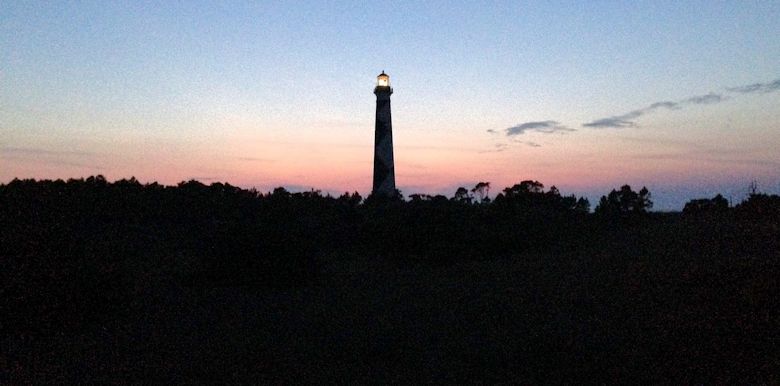
The Light That Binds
Some of descendants gathered on porch of the lightkeeper’s house at Cape Lookout as the sun set behind Shackleford Banks. They had spent the day sharing stories and memories. They had supped on grilled mullet and had climbed to the top of the light that so bound their ancestors. They were listening to stories about Billy Hancock, purported to be the fastest man on the Banks, and the day the taxman came over to collect back taxes. He threatened to take a fisherman’s seaweed-filled mattress.
“Go ahead,” the fisherman said. “When the tide goes out, I’ll make me another.”
It was a hard day for Karen Willis Amspacher, the executive director of the Core Sound Waterfowl Museum & Heritage Center. There were meals to coordinate for the reunion, speakers to shepherd, ferry schedules to meet. That was easy, though, compared to the other stuff, the emotional stuff.
She wanted the reunion to be more than just a gathering of people with a common history. “It had to be personal,” said Amspacher, a native of Harkers Island. “Otherwise it would be just another event.”
She also wanted it to be a celebration of a way of life that often brought shame and ridicule because of the way people talked or the way they made a living. “You had to grow up and talk right,” she said. “It’s not that way anymore and we can hold our heads high.”







